For those in need of a chilled white wine to help beat the heat, Wine Lister’s latest blog transports you to Italy, examining a selection of dry Italian whites with WL scores of 90 and above. Enjoy any of the below from the comforts of your home:
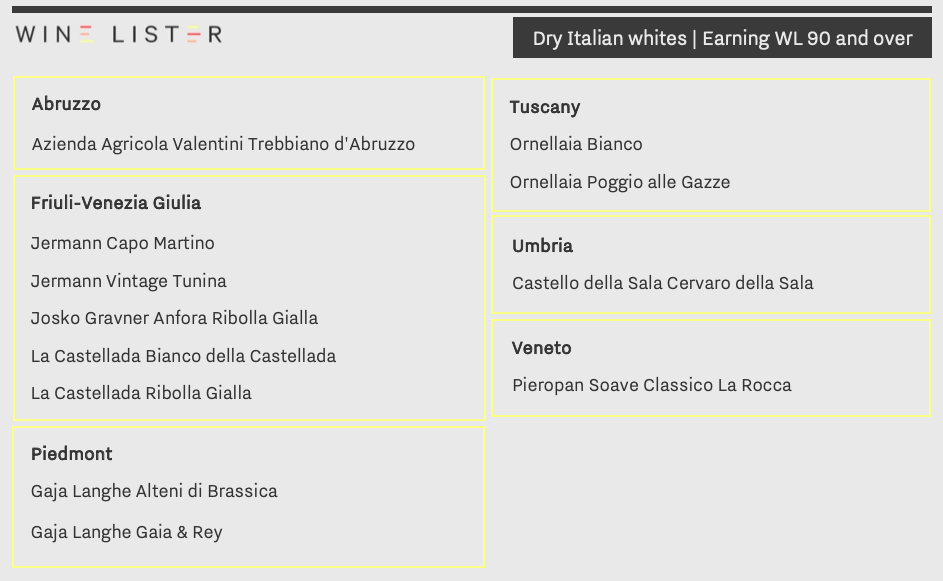
Abruzzo – Azienda Agricola Valentini Trebbiano d’Abruzzo
Valentini’s Trebbiano d’Abruzzo is one of Italy’s most prominent dry whites, benefitting from remarkable ageing potential that contributes to its frequent comparison with fine white Burgundy. Described by Walter Speller for Wine Lister partner critic, JancisRobsinon.com as “much too young right now, but huge promise”, the 2013 vintage can be aged for another 20 years, despite already having a “gorgeous nose of spice, flint stone and mandarin fruit”. The quality of its production can be attributed to the estate’s judicious approach to grape selection, using a mere five percent of the harvest from its 170 acres of vineyards to make its own wine, and selling the rest to local co-ops. A Wine Lister MUST BUY, the 2013 Valentini Trebbiano d’Abruzzo achieves a WL score of 95 at c.£105 per bottle (in-bond). You can place a bid for this wine on the Berry Bros & Rudd online bidding platform, BBX.
Friuli-Venezia Giulia – Josko Gravner Anfora Ribolla Gialla
Situated on the Slovenian border, Josko Gravner has pioneered biodynamic winemaking in Italy. Given the plethora of high-tech winemaking equipment that exists today, his methods can be considered somewhat antiquated – his winery is stripped bare, apart from the necessary electricity for lights. Wines are fermented in underground Amphorae, filled by gravity, and aged in traditional wooden casks. An Italian indigenous grape, the Ribolla is aged for a considerable number of years before release, with the 2009 vintage displaying “fabulous aromas of dried grasses, chamomile, lapsang and smoked orange peel” and a “dry spicy grip”, according to Julia Harding for JancisRobinson.com. With a WL score of 92 at c.£70 per bottle (in-bond), this MUST BUY is available to purchase by the bottle from The Good Wine Shop.
Piedmont – Gaja Langhe Gaia & Rey
Named after Angelo Gaja’s daughter (and now fifth-generation director), Gaia Gaja, and his grandmother, Clotilde Rey, Gaia & Rey was first produced in 1983. Made from the first Chardonnay vines to be planted in Piedmont, this wine pioneered the production of exceptional white wines in the Langhe Hills, where production had previously been almost exclusively red. With a WL score of 93, the 2016 vintage can be enjoyed now, or laid down for further ageing. Wine Lister partner critic Antonio Galloni for Vinous describes it as “a gorgeous Chardonnay built on persistence, energy and class. Orchard fruit, citrus, almond and floral notes give the 2016 striking vibrancy”. It is available to purchase by the case of 12 for £939 (in-bond) from Cru World Wine.
Veneto – Pieropan Soave Classico La Rocca
The Pieropan family have been producing wines in Soave since the late 1880s, and were the first to bottle wine under the Soave label in the early 1930s. The late Leonildo “Nino” Pieropan, grandson of the estate’s founder, was also the first producer in Soave to make a single-vineyard wine, ‘Calvarino’, in 1971. Pieropan’s Soave Classico La Rocca is made from Garganega grapes grown on La Rocca’s unique terroir, which exists as a limestone outcrop in a sea of Soave’s basalt. Gaining a WL score of 92, and available at less c.£20 per bottle (in-bond), the 2013 vintage is a Wine Lister Value pick. Jancis Robinson describes it as “lively and citrus” with notes of “lemon cream”. It can be bought by the bottle from The Wine Centre.
Also featured in the list of Italian whites with WL scores above 90 are: Castello della Sala Cervaro della Sala, Fattoria Zerbina Arrocco Passito, Fattoria Zerbina Scaccomatto Passito, Gaja Langhe Alteni di Brassica, Jermann Capo Martino, Jermann Vintage Tunina, La Castellada Bianco della Castellada, La Castellada Ribolla Gialla, Ornellaia Bianco, and Ornellaia Poggio alle Gazze.
For bespoke fine wine purchase recommendations, as well as advice on collection re-sale, get in touch with our team at team@wine-lister.com, or download the full Cellar Analysis information pack.
Many wine lovers like us have been making the most of lockdown to explore outside of the more traditional wine-growing regions and grape varieties. Wine Lister’s new cellar analysis service can include tailored guidance on future purchases for drinking or investment, providing recommendations for top-quality wines from alternative producers and regions.
To help you discover some of these brilliant New World picks, the Wine Lister team has put together a short selection of MUST BUYs that have exhibited a recent rise in popularity, as established through search frequency data from Wine-Searcher.
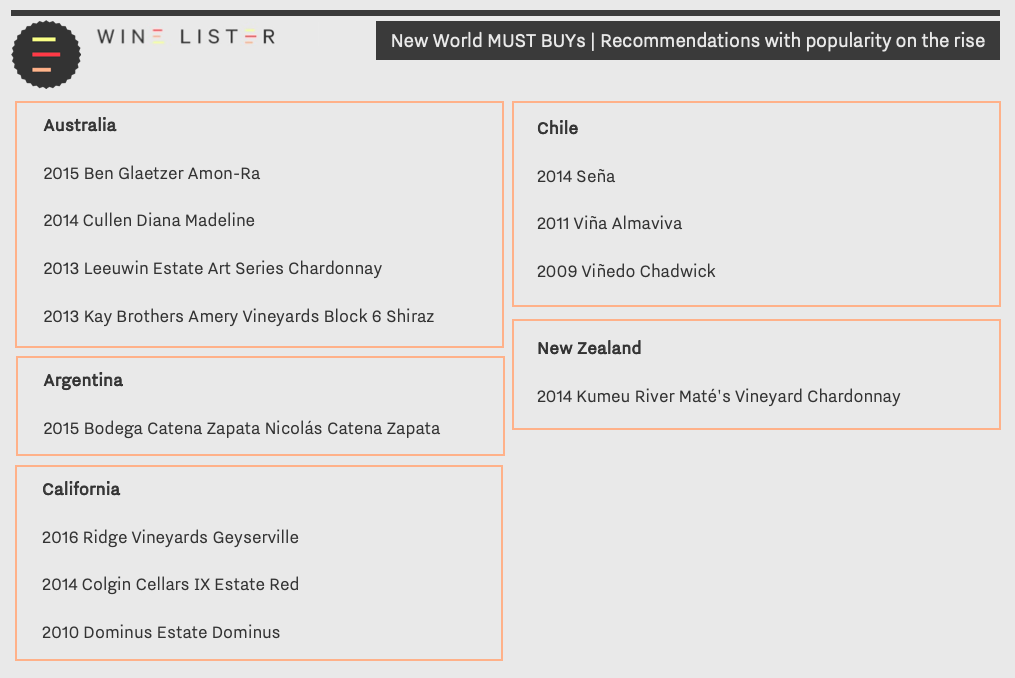
Australia to ask for – 2014 Cullen Diana Madeline
Founded in 1971, the Cullen Estate has maintained concern for its environment since its inception, keeping both chemical intervention and irrigation to a minimum. In 1998, the estate adopted an organic viticulture, which was further developed into a biodynamic practice in 2008. Winemaker, Vanya Cullen, states the biodynamic approach to harnessing Earth’s energy “achieves greater individuality of site through working with nature rather than against it”, suggesting its ability to better display terroir and climate. The estate’s flagship wine, Diana Madeline, comprises a blend of 89% Cabernet Sauvignon with small amounts of Petit Verdot, Merlot, Malbec, and Cabernet Franc in 2014. With a WL score of 95 at £50 per bottle (in-bond), it is described by Wine Lister partner critic, Jancis Robinson, as “refined and elegant”, and displaying “great harmony”. It can be bought by the case of 12 from BI Fine Wine & Spirits.
Argentina to acquire – 2015 Bodega Catena Zapata Nicolás Catena Zapata
Nicolás Catena Zapata helped pioneer the use of European winemaking techniques in Argentina’s high altitudes, following in the footsteps of his grandfather, Nicola Catena – an Italian immigrant who founded the winery in 1902. The inaugural vintage of the namesake wine (1997) was debuted in the USA and Europe at a series of blind tastings, where it received comparison to First Growths Latour and Haut-Brion, and achieved either first or second place in every event. Composed of 83% Cabernet Sauvignon and 17% Malbec in 2015, Nicolás Catena Zapata grapes are fermented in 100% French Oak barrels for 15 days. Fermentation temperatures are kept low, to extract pronounced aromas, while cap management is done by hand to encourage the extraction of nuanced flavours and gentle tannins. The 2015 Nicolás Catena Zapata receives a WL score of 94, at £49 per bottle (in-bond), and can be acquired by the case of 12 from Fine+Rare Wines.
California to call upon – 2010 Dominus Estate Dominus
Owned by Christian Moueix (of Petrus fame), Dominus Estate demonstrates its prestigious proprietorship with one of the highest quality Bordeaux blends in California. Comprised of 95% Cabernet Sauvignon, and 5% Petit Verdot, the 2010 Dominus Estate Dominus was produced in the smallest quantities known to the property since its 1984 vintage – consequential of a rigorous selection of lots for the final blend. Wine Lister partner critic, Antonio Galloni, calls the 2010 “a towering, utterly magnificent wine”, describing “asphalt, licorice, menthol, plums and cassis” that “wrap around the palate and never let up”. With a WL score of 98, at £233 per bottle (in-bond), it can be aged for another 20 years, and is available to purchase by the case of six from Corney & Barrow.
Chile to chase – 2014 Seña
A blend of 60% Cabernet Sauvignon, 16% Carménère, 11% Malbec, 8% Merlot, and 5% Petit Verdot, the 2014 Seña was described by WL partner critic, Jeannie Cho Lee as a “fabulous wine that offers layers of flavors that range from exotic spices, rose petals and violets to blackberries and fresh herbs”. Owner Eduardo Chadwick tells us of his addition of the late-ripening Petit Verdot, which adds spice and complexity to the wine. With extremely fine-grained tannins and acidity, thanks to its cool climate, the wine has received several comparisons with top Bordeaux blends. Achieving a WL score of 96, at £78 per bottle (in-bond), the 2014 Seña can be bought by the case of six from Lay & Wheeler.
New Zealand worth knowing – 2014 Kumeu River Maté’s Vineyard Chardonnay
Achieving a WL score of 94 at £38 per bottle (in-bond), the 2014 Kumeu River Maté’s Vineyard Chardonnay constitutes a good value New World Chardonnay with excellent ageing potential (it can be aged for a further 10 years). Wine Lister partner critic, Neal Martin, describes the 2014 vintage as having “a riveting, brilliantly defined bouquet of oyster shell, citrus peel and apple blossom”, concluding that it is “world-class stuff”. Having taken over the estate from his Dalmatian father, Maté, in 1982, Kumeu River director, Michael Brajkovich, was the first New Zealander to become a Master of Wine, and used his knowledge to develop its viticulture through improving drainage, growing grass between the vines, and introducing a Lyre trellis system. Named after Michael’s late father, the 2014 Kumeu River Maté’s Vineyard Chardonnay is available to purchase by the bottle from Lay & Wheeler.
Also featured in the above MUST BUY recommendations are: 2016 Ridge Vineyards Geyserville, 2015 Ben Glaetzer Amon-Ra, 2014 Colgin Cellars IX Estate Red, 2013 Kay Brothers Amery Vineyards Block 6 Shiraz, 2013 Leeuwin Estate Art Series Chardonnay, 2011 Viña Almaviva, and 2009 Viñedo Chadwick.
For bespoke fine wine purchase recommendations, as well as advice on creating the financial room with re-sale suggestions, get in touch with our team at team@wine-lister.com, or download the full Cellar Analysis information pack.
Thanks to solid discounts on existing market prices from many châteaux, the Bordeaux 2019 en primeur campaign can be considered a success, and may prove in the long-term to have helped the en primeur system find its feet once again, in terms of the cost benefit it offers to buyers.
Part II of Wine Lister’s Bordeaux Study, In sickness, in health discusses this in more detail. In the meantime, below we have selected top MUST BUYs at different price points, to help those still on the hunt for Bordeaux 2019.
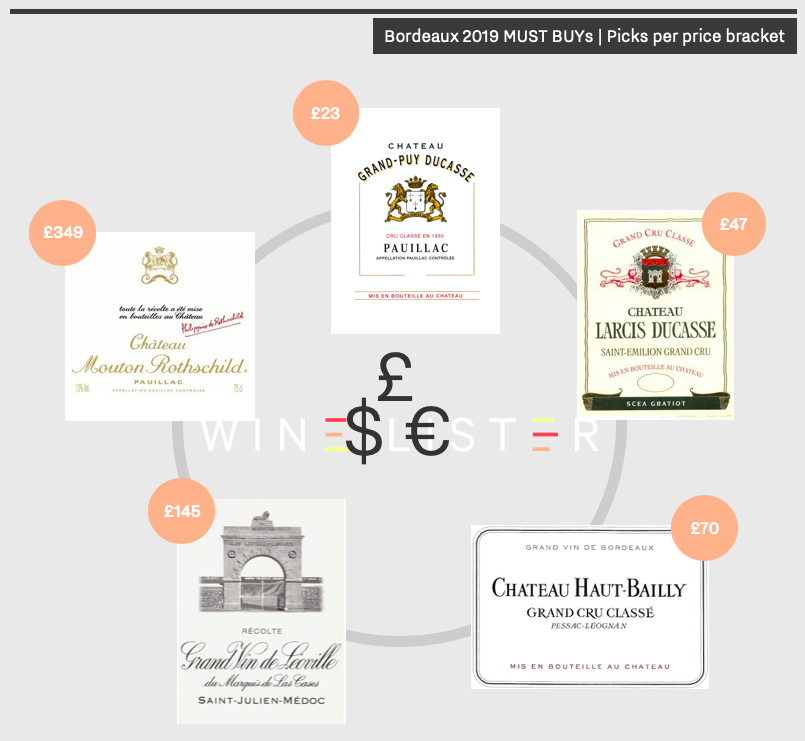
Under £25 – Grand-Puy-Ducasse
Grand-Puy-Ducasse 2019 is both a MUST BUY and a Value Pick, achieving its best ever WL score of 93 in 2019, available at £23 per bottle (in-bond) when buying by the case. The latest release illustrates the contrasting climatic conditions of 2019, with critics noting its complexity and nuance. Wine Lister partner critic, Neal Martin, notes, “crisp tannins, a fine bead of acidity, cohesive and harmonious with a lovely saline/briny note”, adding “this is one of the best Grand Puy Ducasse wines that I have encountered from barrel. Excellent”. Grand-Puy-Ducasse 2019 is available to purchase by the case from Justerini & Brooks.
More Bordeaux 2019 MUSY BUYs under £25: Capbern, Gloria, Laroque, Meyney, Potensac, and Siran.
Under £50 – Larcis-Ducasse
At £47 per bottle (in-bond), Larcis-Ducasse 2019 is priced notably well within the wider context of Saint-Émilion Grand Cru Classé “B” releases. As examined in a recent en primeur blog, it earns a WL score of 95 – just one point less than the likes of Cheval Blanc and Pavie (costing on average six times less than its Classés “A” neighbours). Winemaker, David Suire, observes that the vintage reflects clearly its limestone terroir, showing floral notes and an overriding minerality. Wine Lister partner critic, Antonio Galloni, concurs, noting “graphite, menthol, licorice, tobacco and cedar notes” in the bouquet, coining it “one of Bordeaux’s most under the radar gems”. While demand for this wine has likely been strong, Larcis-Ducasse 2019 is still available through Millésima’s UK and Hong Kong branches.
More Bordeaux 2019 MUST BUYs under £50: Brane-Cantenac, Giscours, Grand-Puy-Lacoste, La Gaffelière, Malescot Saint-Exupéry, and Pavie-Macquin.
Under £100 – Haut-Bailly
At £70 per bottle (in-bond), Haut-Bailly 2019 shares the château’s top WL score (95) with recent vintages 2018, 2016, 2015, and 2014. Managing Director, Veronique Sanders, told the Wine Lister team of their need to light fires five times to prevent frost in the spring of 2019, escaping unscathed. In the end, challenges throughout the growing season concluded in perfect harvest conditions, and a wine of impressive balance and energy. Indeed, the 2019 has received unanimous confidence from critics – Neal Martin states that the 2019 is a “more terroir expressive Haut-Bailly that has an effortless allure and a sense of sophistication”, concluding that it is “wonderful”. Haut-Bailly 2019 can be acquired by the case through Goedhuis & co.
More Bordeaux 2019 MUST BUYs under £100: Calon Ségur, Canon-la-Gaffelière, Canon, Clinet, Léoville Poyferré, Pontet-Canet, Lynch-Bages, Montrose, and Troplong-Mondot.
Under £200 – Léoville Las Cases
Léoville Las Cases 2019 achieves a WL score of 97, at £145 per bottle (in-bond). While volumes of the 2019 released onto the market were down 35% on last year, there is still some availability of this Saint-Julien super second, and we highly recommend getting your hands on some. Wine Lister’s CEO, Ella, describes it as “luminous and lyrical”, noting a bouquet of “English garden – raspberry blossom, cow parsley, fraises de bois, and then a deeper note of ripe cherries”. James Lawther for JancisRobinson.com is similarly impressed, awarding it 19 points and noting it as “one of the greats from this estate”. The latest vintage can be purchased through Fine+Rare.
More Bordeaux 2019 MUST BUYs under £200: Figeac, Haut-Brion, La Conseillante, La Mondotte, Le Petit Mouton, La Mission Haut-Brion, Palmer, Pichon Comtesse, and Vieux Château Certan.
Over £300 – Mouton
While the release price of this Pauillac Premier Cru, let alone the quality of its 2019, likely makes it one of the most popular buys of the campaign, there may still be opportunities to secure some en primeur. Released at £299 per bottle (in-bond), Mouton 2019 achieves a WL score of 97 – the second-highest score achieved by the château in recent years, following the 2016’s 98. Wine Lister’s CEO, Ella Lister, describes Mouton 2019 thus: “velveteen tannins, long and caressing”, recounting “complex, savoury flavours of graphite and slate intermingled with the generous fruit”. Farr Vintners still appears to have some availability of Mouton 2019 (albeit at a slightly higher price than its release).
More Bordeaux 2019 MUST BUYs over £300: Cheval Blanc, Lafite, and Lafleur.
French readers can find this blog in French translation on Le Figaro Vin’s website.
Wine Lister Pro members can read Part II of the Bordeaux study here. All free users can purchase the report for £125 from Wine Lister’s Analysis page (available in both English and French).
This week, Wine Lister published Part II of its annual in-depth Bordeaux Study, In sickness, in health, which, among other inquiries, examines the 40 top-quality crus in 2019. As illustrated in the study, tastings have so far indicated high quality levels across the board in 2019, while numerous wines have made significant advancements, shaking up this year’s rankings.
Following this line of investigation, below we examine the top 25 Bordeaux 2019s by WL score (as separated by mere decimals), and consider the biggest movers since last year. These scores are informed by the recently-released ratings of Wine Lister partner critics, Bettane+Desseauve, Antonio Galloni and Neal Martin for Vinous.com, and James Lawther for JancisRobinson.com.
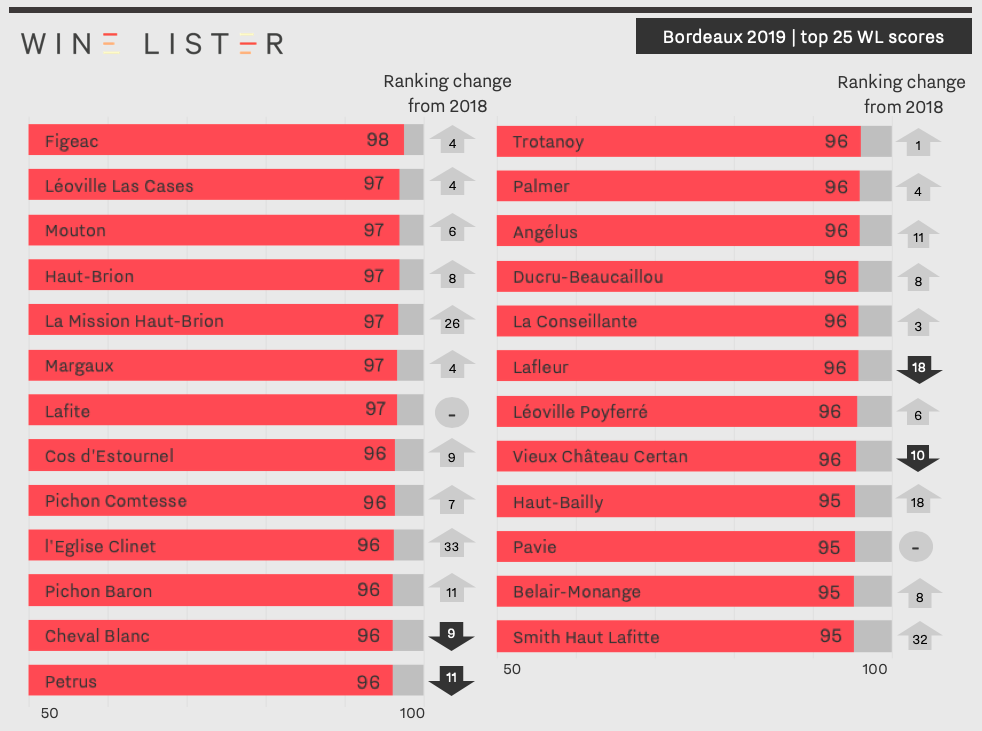
Consistent with last year’s ranking of Bordeaux 2018s by Quality score (conducted before the introduction of Wine Lister’s free site, featuring WL scores out of 100), Pomerol earns the highest number of places (six) in the top 25 2019s by WL score. Neighbouring Saint-Emilion follows closely behind with five spots in this year’s ranking, including the top-scoring wine of the vintage, Figeac 2019, which achieves a WL score of 98.
The four first growths to release their 2019s en primeur appear in third through seventh places, intersected by La Mission Haut-Brion’s entry at fifth place. This promising Pessac-Léognan climbs an impressive 26 spots in 2019, and, as mentioned in our previous blog, has been recently assigned MUST BUY status. Neal Martin scores La Mission Haut-Brion 2019 98-100 points, declaring: “I wager that ultimately this will become one of the wines of the vintage”, concluding that the wine is “breathtaking”.
L’Eglise Clinet sees an impressive upwards shift of 33 places this year, entering the top 10 with a WL score of 96. A poignant tribute to its late winemaker, Denis Durantou, its 2019 has received significant praise, with Antonio Galloni noting that it is “very clearly one of the wines of the year. A Pomerol of soaring, majestic intensity, L’Eglise-Clinet dazzles from start to finish”.
Pichon-Baron and Angélus both climb eleven places in this year’s top-25 ranking, to 11th and 16th place, respectively, with the former receiving top scores from both Neal Martin and Antonio Galloni. Both critics allude to the depth of Pichon-Baron’s 2019, with Galloni stating that “pomegranate, chocolate, licorice and spice are all lavishly expressed”. This represents one of Pauillac’s four entries on this year’s top-25 ranking, which also comprises Mouton, Lafite, and Pichon Comtesse.
Haut-Bailly makes a sizeable leap of 18 places since last year, ranking in 21st place with a WL score of 95. At £70 per bottle (in-bond) Haut-Bailly 2019 is also a Wine Lister MUST BUY. Fellow Pessac-Léognan producer, Smith Haut Lafitte, climbs an impressive 32 places with its 2019 vintage, rounding out the top 25 list. Having tasted twice, Neal Martin describes its “intense, very pure bouquet with blackberry, briary and cherry compote and a hint of black olive tapenade in the background”.
Also featured in the top 25 Bordeaux 2019s by WL score are: Belair-Monange, Cheval Blanc, Cos d’Estournel, Ducru-Beaucaillou, Haut-Brion, La Conseillante, Lafleur, Léoville Las Cases, Léoville Poyferré, Margaux, Palmer, Pavie, Petrus, Trotanoy, and Vieux Château Certan.
Wine Lister Pro members can read Part II of the Bordeaux study here. All free users can purchase the report for £125 from Wine Lister’s Analysis page (available in both English and French).
With the Bordeaux 2019 en primeur campaign now concluded, we bring you 38 new Wine Lister MUST BUYs. The tasting of Bordeaux 2019 has thus far confirmed the notable quality of the vintage, from which we have filtered some obvious campaign buys that can be expected to see increased prices, and decreased availability in the future.
Wine Lister’s MUST BUY recommendation algorithm takes into account a wine’s quality and value within its vintage and appellation, as well as the latest industry intelligence from key players in the global fine wine trade. These results are then filtered through an intelligence-based, human overlay, which identifies MUST BUY wines based on our tasting of Bordeaux 2019, and observation of the reception of each release in the market.
As illustrated below, there are 38 Bordeaux 2019s that are now recognised as MUST BUYs – suggesting that the benefit of buying en primeur is more obvious than last year (there were 24 Bordeaux 2018 en primeurs recognised as MUST BUYs following its campaign). They are all red:
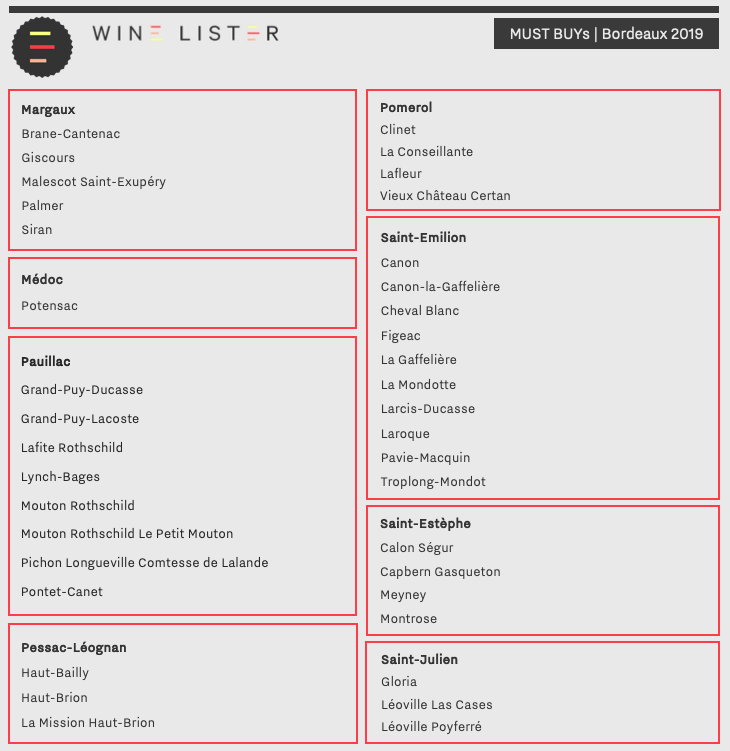
In keeping with last year’s MUST BUY picks, Saint-Emilion once again ranks as the most recommended appellation – this year offering 10 MUST BUYs, including the top-scoring wine of the vintage: Figeac 2019. With a WL score of 98, Figeac’s latest vintage has sustained the château’s upward quality trajectory.
With a WL score of 93 at £18 per bottle (in-bond), Laroque 2019 exhibits excellent value relative to 2019 Saint-Emilions of comparable quality. Alongside its MUST BUY status, Laroque’s latest vintage is also a Value Pick, making it an essential acquisition for the savvy Bordeaux buyer. Wine Lister partner critic, Antonio Galloni, notes, “raspberry jam, spice and red plum meld into the juicy finish”, stating that “the 2019 is very nicely done”.
Pauillac houses eight Bordeaux 2019 MUST BUYs, including first growths Lafite and Mouton, which both achieve WL scores of 97. Grand-Puy-Ducasse 2019 is both a MUST BUY and a Value Pick, having achieved a WL score of 93 at £23 per bottle (in-bond). Writing for Jancisrobinson.com, James Lawther muses whether the 2019 is the, “best of recent vintages?”, suggesting that it “certainly has more structure and power with additional mid-palate flesh”. As proposed in a previous Bordeaux 2019 en primeur blog, Pichon Comtesse is another notable Pauillac purchase for wine collectors, given the estate’s impressive popularity, and its vast reduction in volume released this year.
Within its five MUST BUY picks (four at under £50 per bottle in-bond), Margaux contains two Value Picks, with Malescot Saint-Exupery and Siran priced at £31 and £20 per bottle (in-bond), respectively. At £167 per bottle (in-bond) Palmer 2019 shows good value within the context of its previous vintages (31% below the 2018 and 2016 release prices), which, alongside its limited quantity released en primeur, makes this a must for Margaux enthusiasts.
In Pomerol, La Conseillante, Lafleur, and Vieux Château Certan achieve WL scores of 96, while Clinet follows shortly behind with 95. At £54 per bottle (in-bond) the latter is notably cheaper than its Pomerol peers, and has made a major leap up in quality from previous vintages. Awarding it 97-99 points, Neal Martin writes that Clinet 2019 “is just so fragrant on the nose”, stating that, “the purity that Ronan Laborde and his team have achieved should be applauded”.
Calon Ségur and Montrose lead Saint-Estèphe’s four MUST BUYs with a shared WL score of 95, while Meyney and Capbern provide testament to the value proposition available in the appellation, having been priced at £19 and £15 per bottle (in-bond), respectively.
Sharing three picks apiece are further left bank appellations Saint-Julien and Pessac-Léognan, which are both home to high-scoring 2019s. In Saint-Julien, Léoville Las Cases achieves a WL score of 97 – matched by Pessac-Léognan first growth Haut-Brion, and neighbour, La Mission.
Other wines featured in Wine Lister’s Bordeaux 2019 MUST BUYs are: Brane-Cantenac, Canon, Canon-la-Gaffelière, Cheval Blanc, Giscours, Gloria, Grand-Puy-Lacoste, Haut-Bailly, Le Petit Mouton, La Gaffelière, La Mondotte, Larcis-Ducasse, Léoville Poyferré, Lynch-Bages, Pavie-Macquin, Pontet-Canet, Potensac, and Troplong-Mondot.
Wine Lister has now released Part II of its annual in-depth Bordeaux Study, examining the price and quality of Bordeaux 2019, relative to previous vintages. Purchase the full report here, or download using your Pro subscription (available in both English and French).
With the Bordeaux 2019 en primeur campaign now behind us, Part I of Wine Lister’s 2020 Bordeaux Study examines the results of our latest in-depth trade survey. Answered by 50 key players across major fine wine markets, the results provide insight into the wine trade’s latest position on the region, including its level of confidence in specific wines.
The trade’s faith in Bordeaux brands has increased on the whole since last year, with more Bordeaux wines moving up in their confidence rating than down. For the fourth consecutive year, no Bordeaux wine received a confidence rating of 10/10. Brands that have retained their 9/10 confidence rating since last year are Lafleur, Le Pin, Margaux, Mouton, Petrus, and Vieux Châteaux Certan.
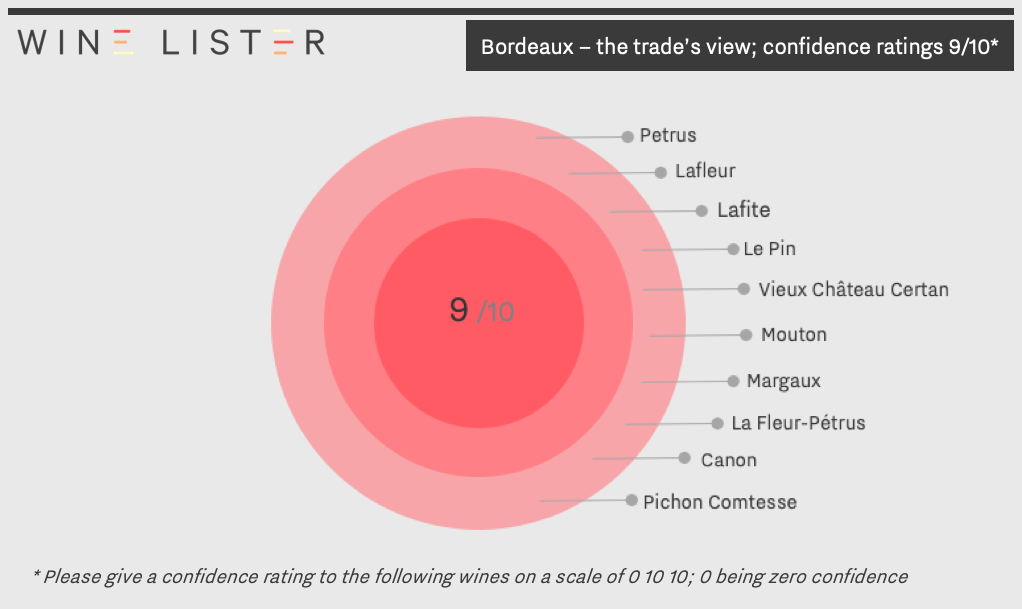
Joining them in 2020 are Canon, La Fleur-Pétrus, Lafite, and Pichon Comtesse, while Latour has moved down a rating since last year, to 8/10. The survey was, however, conducted prior to the first growth’s successful 2012 release (27th May) at c.£350 per bottle, marking its first release of a vintage exclusively as mature stock.
There are 28 Bordeaux wines that earn a confidence rating of 8/10 in 2020, with nine joining them since last year: Angélus, Ausone, Belair-Monange, Carruades de Lafite, Grand-Puy-Lacoste, La Mission Haut-Brion, Montrose, Palmer, and Pavillon Blanc.
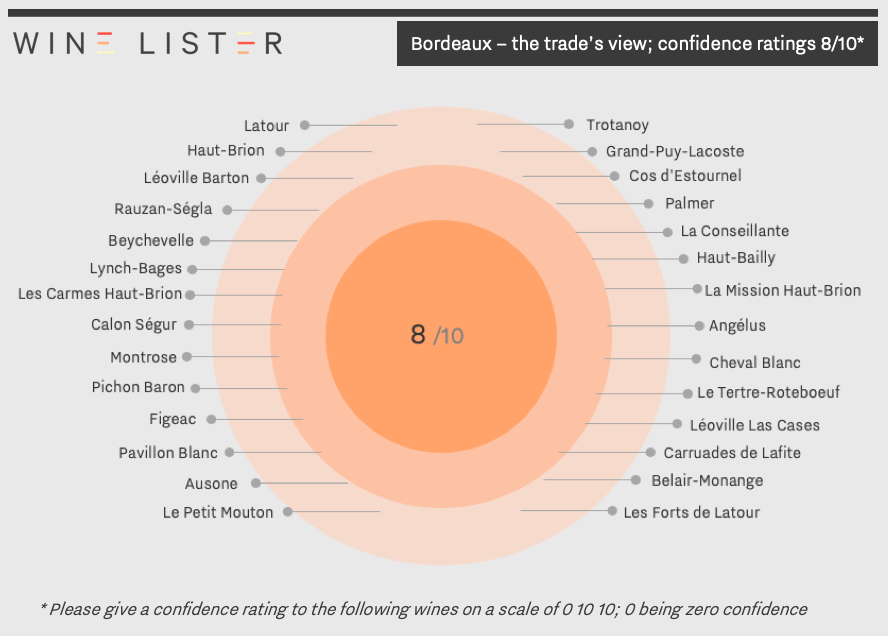
Though Margaux’s Pavillon Rouge moves down to a rating of 7/10 in 2020, three younger siblings of first growths stay at a rating of 8/10: Carruades de Lafite, Le Petit Mouton, and Les Forts de Latour.
Part II of the Bordeaux 2020 study, including a score breakdown of 2019s, and further retrospective analysis of the en primeur campaign, will be published shortly. Watch this space.
In the meantime, visit the Analysis page to purchase Part I, or download using your Pro subscription (available in both English and French).
Now into its second full week, the Bordeaux 2019 en primeur campaign shifted up another gear today, with the release of first growth Mouton Rothschild, and its associated properties.
After the flurry of releases yesterday (Monday 8th June) met with very mixed reviews, Mouton reset the campaign tone, with a price 30% below the current market price of 2018, and under the price of all recent back vintages. Bordeaux buyers no doubt breathed a sigh of relief at the tidy figure – £299 per bottle in-bond – the most obvious buy of the campaign so far (other than Lafleur).
Not only is this release on the money in recognising today’s difficult economic context, as well as Bordeaux’s recent price performance struggles, it also provides a brilliant deal given the reported quality of 2019. Wine Lister’s Founder and CEO, Ella Lister found Mouton 2019 to be floral, elegant, and stately. With a high proportion of Cabernet Sauvignon (90%, vs. an average 83%) it promises a long, prosperous life ahead.
Mouton’s younger sibling, also released this morning, looks equally appealing, if for different reasons. Petit Mouton is one of Bordeaux’s top wines for long-term price performance, and its 2019 release price thus manages to enter the market well under all recent back vintages.
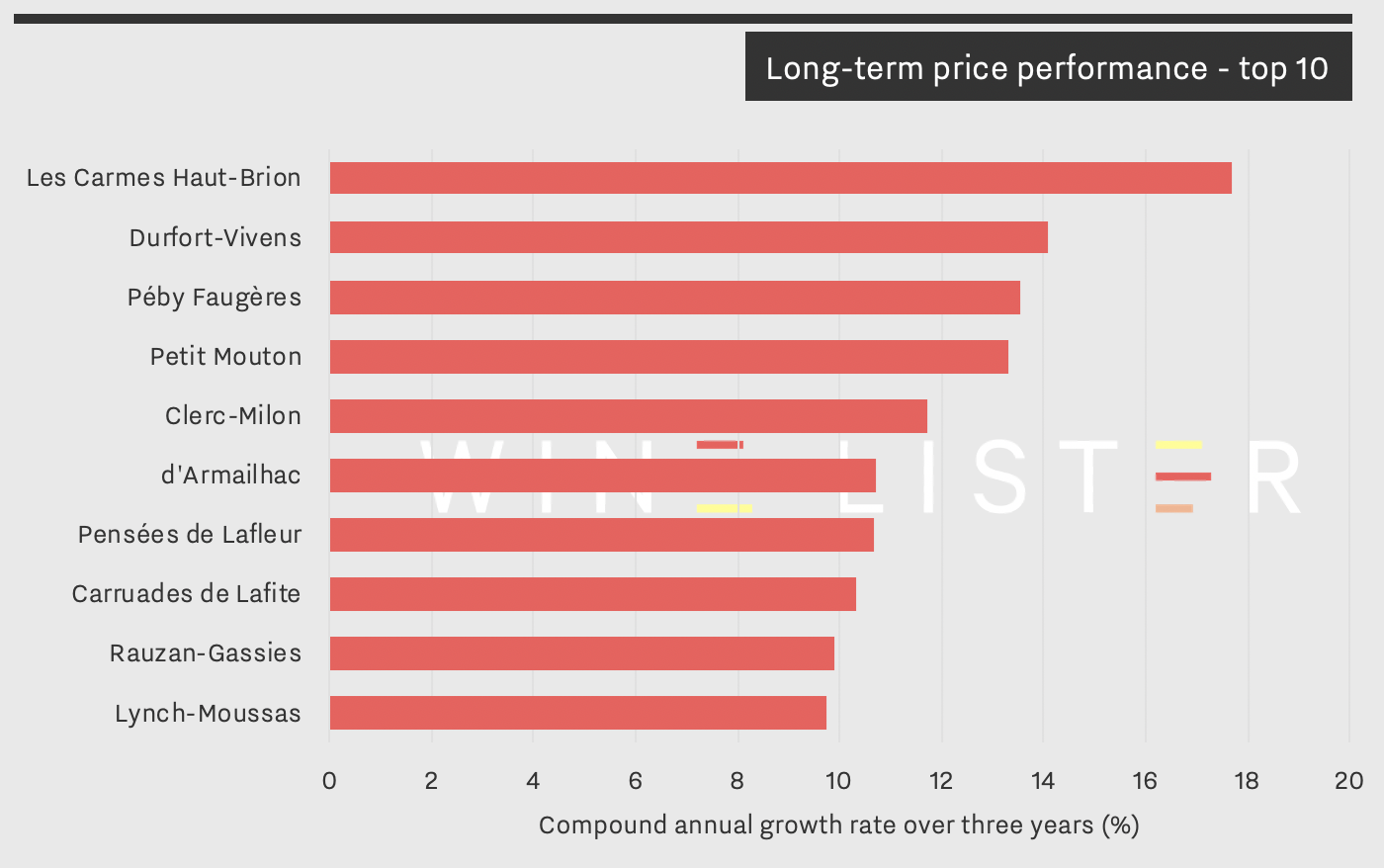 Of major Bordeaux brands, Petit Mouton achieves an average three-year CAGR (compound annual growth rate) of 13.3%, placing it in fourth place of the top 10 long-term price performers, as shown above.
Of major Bordeaux brands, Petit Mouton achieves an average three-year CAGR (compound annual growth rate) of 13.3%, placing it in fourth place of the top 10 long-term price performers, as shown above.
The other 2019s in the Mouton stable, d’Armailhac, Clerc-Milon, and Aile d’Argent were also released today, at prices (per bottle, in-bond) of £31, £52, and £60 respectively.
Yesterday’s hot ticket was right-bank royalty, Cheval Blanc, whose release at £375 also offered consumers a substantial discount on the 2018 release price (32%). Though not yet scored widely by critics, using 2018 as a proxy would mean Cheval Blanc 2019 achieves its joint-highest WL score since the 1961 (alongside the likes of recent greats – 2016, 2015, 2010, 2009, and 2005).
Fellow Saint-Émilion Grand Cru Classé A, Angélus, also released yesterday, though its release price in line with the physically available 2015 perhaps makes it look less attractive. There is nonetheless a real step-change in style and quality happening at Angélus, pioneered by the de Bouärd father-daughter team (Hubert and Stéphanie), which could mean this release is worth investing in for the future.
Two further releases of note from yesterday both hail from Saint-Julien. Branaire-Ducru, a Wine Lister favourite, released its 2019 at £29 per bottle in-bond, 25% down on the 2018 release price. Assuming Branaire’s 2019 is on par with 2018 quality, this is an absolute buy, as the estate’s joint best-ever grand vin at a price beneath all other recent vintages on the market. Léoville-Poyferré 2019 was also released, at £51.34 per bottle in-bond. Offering a 25% discount on last year’s release price for the same quality level, the Saint-Julien second growth is worth considering – having tasted it last week, Lister notes that it is “super-fresh, scented, and luscious”.
Also released so far this week are: Beychevelle, Carillon d’Angélus, Coutet, Gazin, Haut-Bages Libéral, Ferrière, La Gurgue, La Tour Carnet, Larrivet Haut-Brion red and white, and Petit Cheval.
As the first major week of Bordeaux 2019 en primeur releases draws to a close, this morning (Friday 5th June) saw the release of the “first of the Firsts”, and the other reds from the Lafite stable.
Carruades de Lafite 2019 opened the stage with a price of £158 per bottle (in-bond), making it the least expensive Carruades available on the market. The Wine Lister team felt the quality of Carruades saw a significant jump up in 2018, and from what we have heard, the 2019 matches it. With this in mind, and given that volume released onto the market is 50% less than last year, this is a sure buy for anyone seeking access to the Lafite prestige with more approachability.
The grand vin, Lafite 2019, has been released at £426 per bottle in-bond – a discount of c.20% on the 2018’s current market price. The crucial factor this year are the volumes available – also 50% less than last year. On top of this, the single tranche released means buyers will only have one shot to get their hands on the 2019 en primeur (as far as we know). Domaines Baron de Rothschild’s Commercial Director, Jean-Sébastien Philippe, calls Lafite a “modern classic” in 2019, with precision, length, and finesse, but impressive ripeness, making it more approachable than the likes of 2018 or 2016.
Both Lafite and Carruades were cited by the trade as seeing sharp rises in demand (see below) according to Wine Lister’s 2020 Founding Members’ survey. Competition to access both of these wines will therefore likely be high.

Lafite’s Pomerol property, L’Evangile, has released its 2019 grand vin at £146 per bottle in-bond, 15% below the current market price of the 2018. Once again, the Wine Lister team noticed a distinct quality step up in Evangile’s 2018, which we’ve heard has been equalled in 2019. The 2019 reportedly expresses well the move towards a more modern style, and a wine of increasing tension, florality, and freshness, without losing the plush Pomerol profile.
Duhart-Milon 2019 has also been released, at £52 per bottle in-bond. Though the release price puts it more or less in line with market prices of back vintages 2018 and 2016, there is justification to be found in the excellent quality that the Lafite team believe is there in 2019. Philippe explains that Duhart-Milon’s vines sit on a cooler terroir than those of the estate’s Pauillac neighbours, which means in cooler vintages, the wine can be somewhat “austere”. The increasing average temperatures that Bordeaux has seen during recent growing seasons (2018, 2016, and 2015 vintages) therefore only serve to improve the quality of Duhart-Milon, and 2019 certainly had its fair share of heat.
Keep up to date with further Bordeaux 2019 en primeur releases through Wine Lister’s twitter, or through our dedicated en primeur page.
Since its launch in September, Wine Lister’s MUST BUY list has unveiled fine wines across multiple regions, vintages, price points, and drinking occasions, all with the common theme of being so good, that they simply must find their place in fine wine fanatics’ cellars. Wine Lister’s prices are updated weekly, and since price (in the form of value) plays a major part in the MUST BUY algorithm, MUST BUYs too will henceforth be updated weekly.
Since its last update, the MUST BUY list has grown by four wines (to 1,697), with 22 new entries, and 18 wines that have fallen off the list. Following the same trend as last week, nine out of the 22 new MUST BUYs (or 41%) are Burgundian. Big names in Burgundy continue to do well, with three new white Buzz Brands hailing from Raveneau, Jean-François Coche-Dury, and Pierre Yves Colin-Morey respectively.
Elsewhere within white entries are two Rieslings, the Alsatian Hidden Gem, Albert Mann’s l’Epicentre 2008, and the indomitable Joh. Jos Prüm’s Wehlener Sonnenuhr, whose 2011 is now one of seven MUST BUY vintages of this sensational Value Pick.
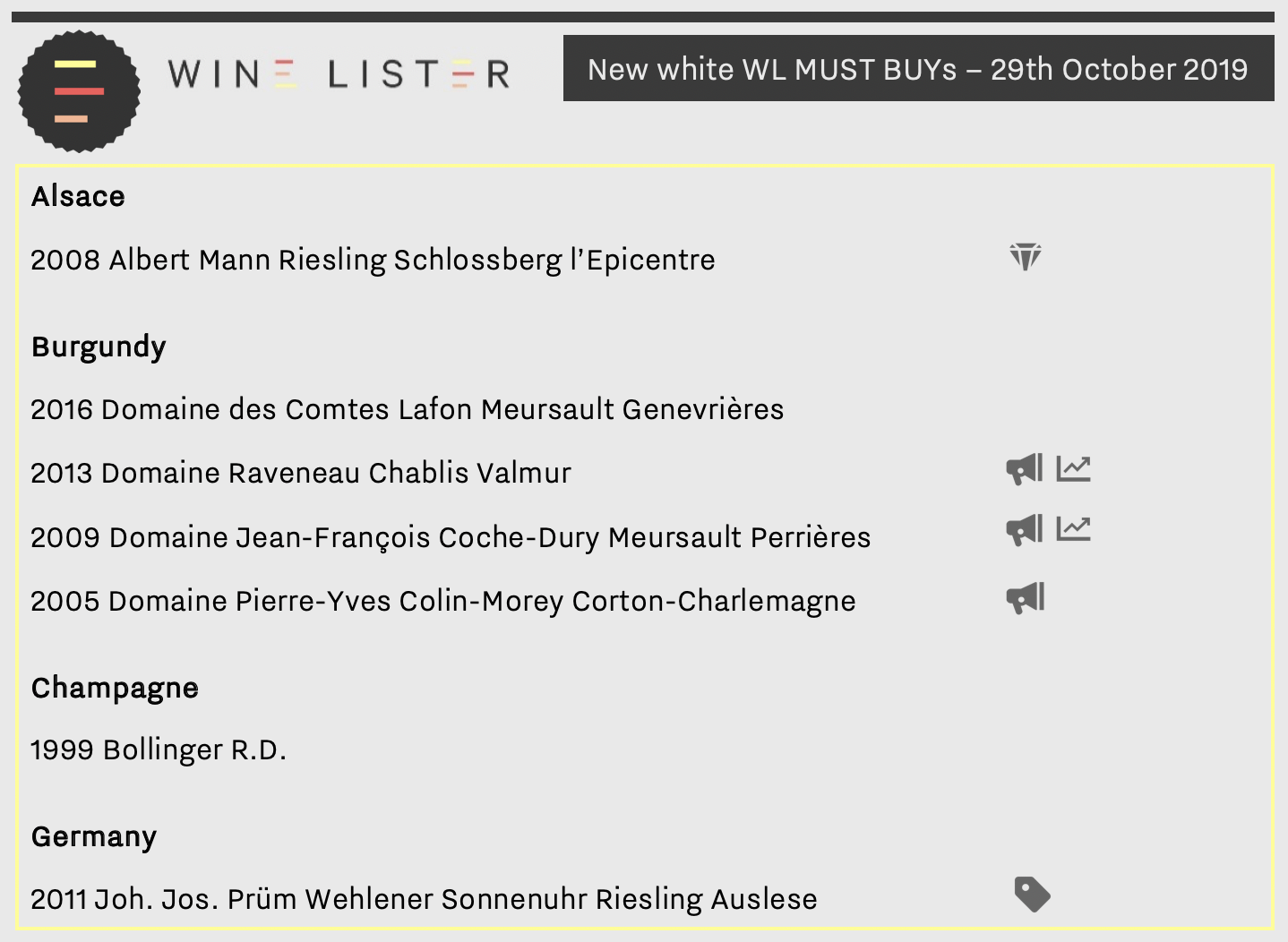
With the clocks turned back and a wintry chill in the air, there are twice as many new red MUST BUYs as white. Burgundy and Italy make the strongest showing, with five reds apiece. Maison Joseph Drouhin sees the addition of its Chambolle-Musigny Les Baudes 2008, bringing the house’s MUST BUY total to 21 wine vintages. Meanwhile Italy’s new MUST BUYs hail from four big name growers: Gaja, Roberto Voerzio, Castello di Ama, and Isole e Olena.
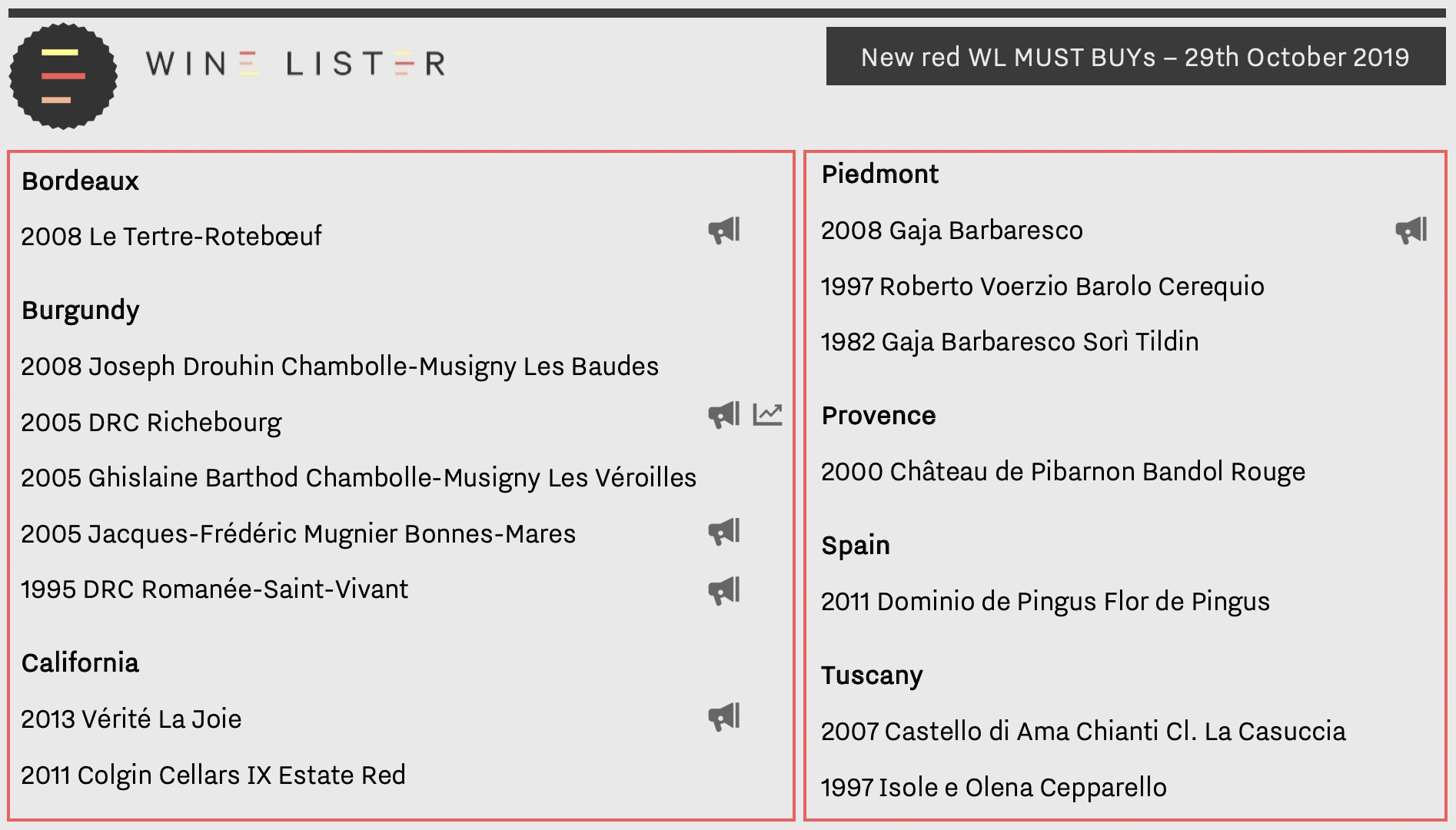
Bordeaux achieves just one entry in Le Tertre-Rotebœuf 2008 (one of nine Bordeaux 2008 MUST BUYs). California also makes its mark, with Vérité’s La Joie 2013 and Colgin Cellars IX Estate Red 2011. Outside of “classic” fine wine regions, Château de Pibarnon’s Bandol Rouge 2000 also enters the fray.
See the full list of current MUST BUYs here.
Wine Lister is excited to announce the arrival of its new consumer site, aimed at supporting fine wine lovers as they navigate the fine wine seas. All users now have unlimited, free access to the world’s most comprehensive fine wine data hub. Start learning how to buy wine like a pro now, or read on to find out more.
WL MUST BUYs
Wine Lister has created its own buy recommendation tool, which combines Wine Lister data with human intelligence (such as the opinion of key members of the global fine wine trade, plus insight from the Wine Lister team’s trips and tastings), to provide a dynamic list of wines any fine wine buyer should consider for their cellar. All MUST BUYs represent high quality, and value within their respective appellations and vintages.
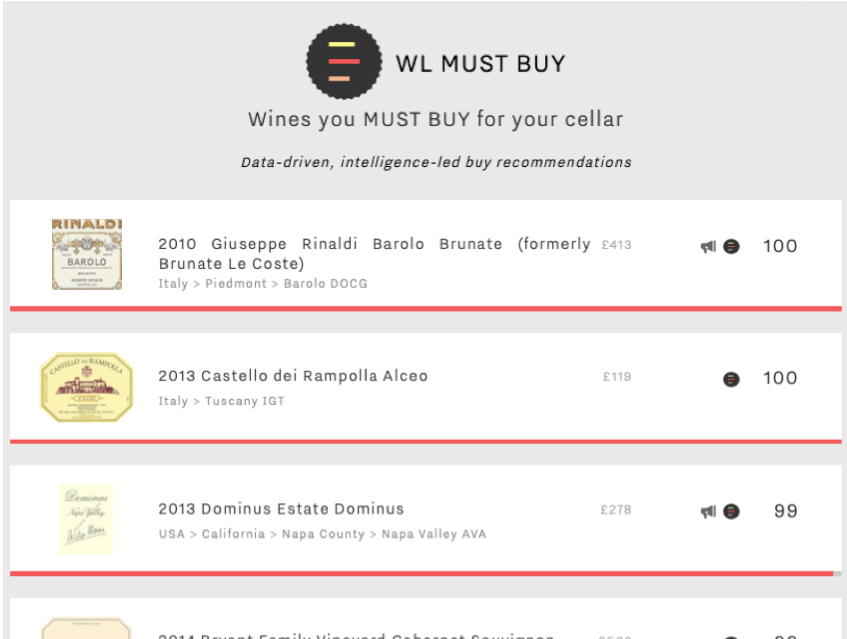 Browse the full MUST BUY list here.
Browse the full MUST BUY list here.
Aggregated, 100-point score
With a focus on quality, the new 100-point Wine Lister Score combines the ratings of five of the world’s most respected wine critics – Jancis Robinson, Antonio Galloni and Neal Martin (Vinous), Bettane+Desseauve, and Jeannie Cho Lee, together with a smaller weighting for the wine’s ageing potential. The score is as objective an indication of wine quality as possible, allowing users to make site-wide comparisons across the 30,000+ wine-vintages on Wine Lister.
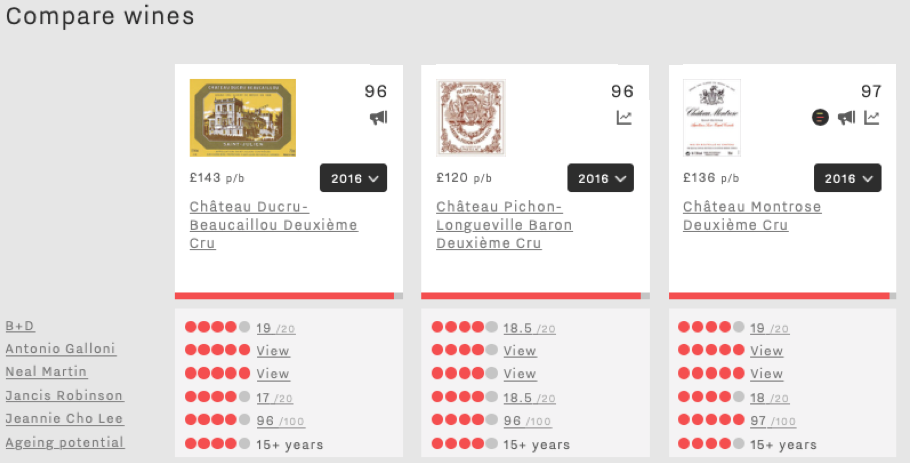
See this comparison, or create your own here.
Further analysis tools
Dynamic charts give users the chance to explore wines they might consider buying or selling in more detail.
The Vintage Value Identifier gives users a clear visual of price to quality ratios across vintages of a given wine, applying a score to this measure of relative value. See the example below for Mouton Rothschild: while the 2016 vintage is higher quality than 2014, its accompanying high price means that both the 2016 and 2014 vintages present the same level of value (the joint-highest of all recent back vintages shown)
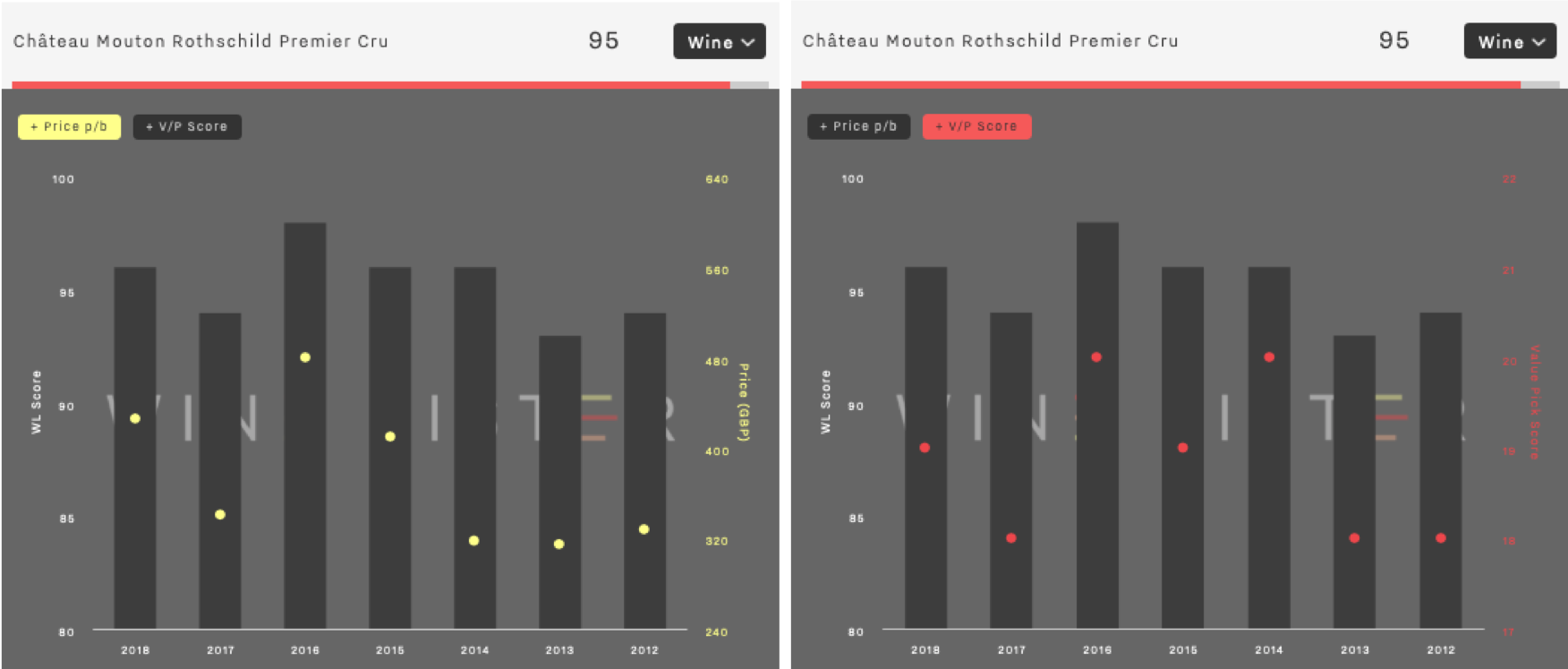 Wine Lister’s dynamic Vintage Value Identifier chart, showing price vs. quality (left) and Value Pick score (right).
Wine Lister’s dynamic Vintage Value Identifier chart, showing price vs. quality (left) and Value Pick score (right).
See the chart for Mouton Rothschild, or search for another wine here.
The Price History chart tracks a wine’s price performance over time, relative to its peer group. This can be done at vintage level, helping collectors to see performance history of a specific wine they might own. See below the example of Domaine Hubert Lignier’s Clos de La Roche 2016, whose price growth over the last year is one of the most impressive of all wines on Wine Lister (57.8%).
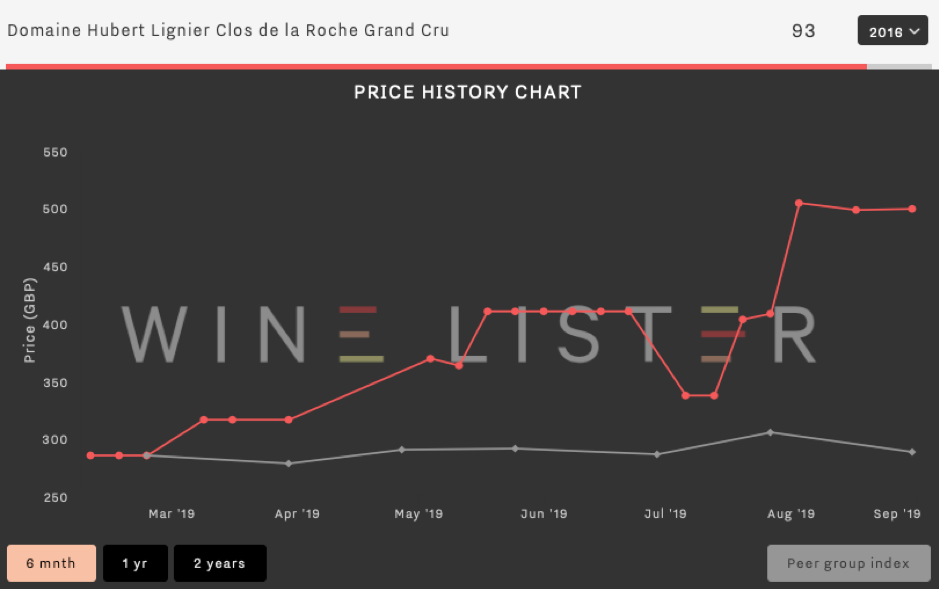 Hubert Lignier Clos de la Roche 2016’s six-month price performance compared to performance of other Clos de la Roche Grand Cru 2016s
Hubert Lignier Clos de la Roche 2016’s six-month price performance compared to performance of other Clos de la Roche Grand Cru 2016s
The same dynamic chart can be used at wine level (an average across vintages, with a stronger weighting for more recent vintages), to give a general indication of a wine’s price trajectory, and therefore whether or not the wine in question could be an investment buy. See below an example for Armand Rousseau’s Chambertin, which on average sees steady price growth, and a CAGR (compound annual growth rate) of 31.8% (though the price has flattened out this year).
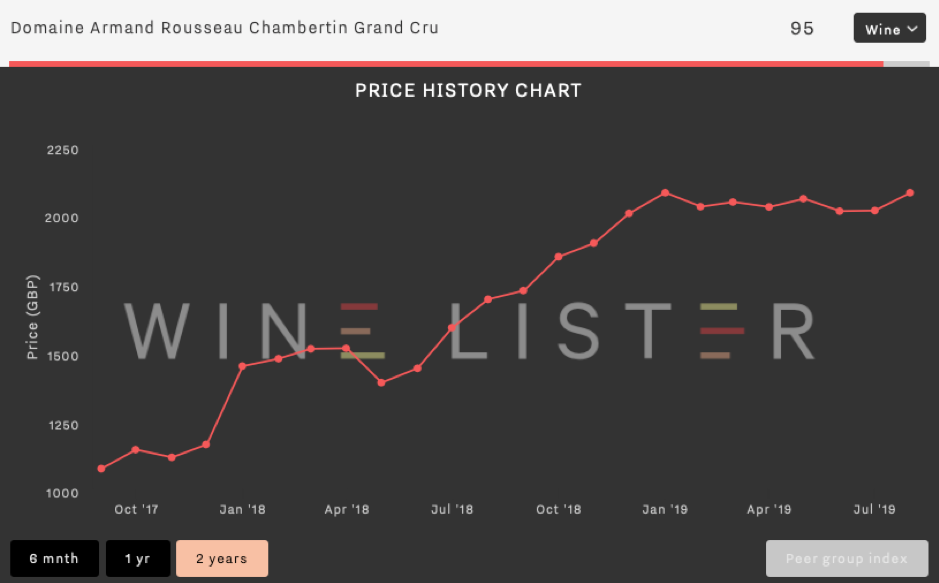 Armand Rousseau’s average price performance over two years
Armand Rousseau’s average price performance over two years
On top of these tools, each wine page gives users further information about the wine in question, including whether the wine qualifies for one of Wine Lister’s four Indicators. Haut Brion, as shown in the example below, is a Buzz Brand. See more information on other segments – Hidden Gems, Value Picks, and Investment Staples, or start browsing here.

We hope that you find the new site informative and useful for developing your fine wine collection. Feedback from our users is always welcome – please don’t hesitate to contact us with any questions or comments here.







 Of major Bordeaux brands, Petit Mouton achieves an average three-year CAGR (compound annual growth rate) of 13.3%, placing it in fourth place of the top 10 long-term price performers, as shown above.
Of major Bordeaux brands, Petit Mouton achieves an average three-year CAGR (compound annual growth rate) of 13.3%, placing it in fourth place of the top 10 long-term price performers, as shown above.


 Browse the full MUST BUY list
Browse the full MUST BUY list 
 Wine Lister’s dynamic Vintage Value Identifier chart, showing price vs. quality (left) and Value Pick score (right).
Wine Lister’s dynamic Vintage Value Identifier chart, showing price vs. quality (left) and Value Pick score (right). Hubert Lignier Clos de la Roche 2016’s six-month price performance compared to performance of other Clos de la Roche Grand Cru 2016s
Hubert Lignier Clos de la Roche 2016’s six-month price performance compared to performance of other Clos de la Roche Grand Cru 2016s Armand Rousseau’s average price performance over two years
Armand Rousseau’s average price performance over two years 